I’m not comfortable admitting that I have a weird soft spot for ruthlessly violent, rightwing Mel Gibson movies, as long as they’re efficiently made.
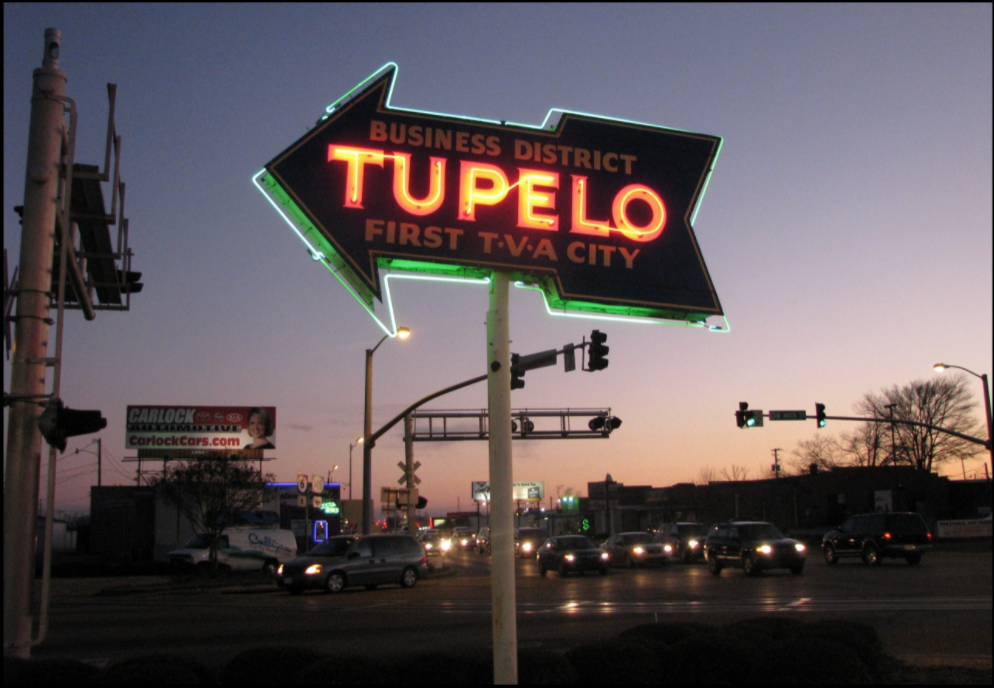
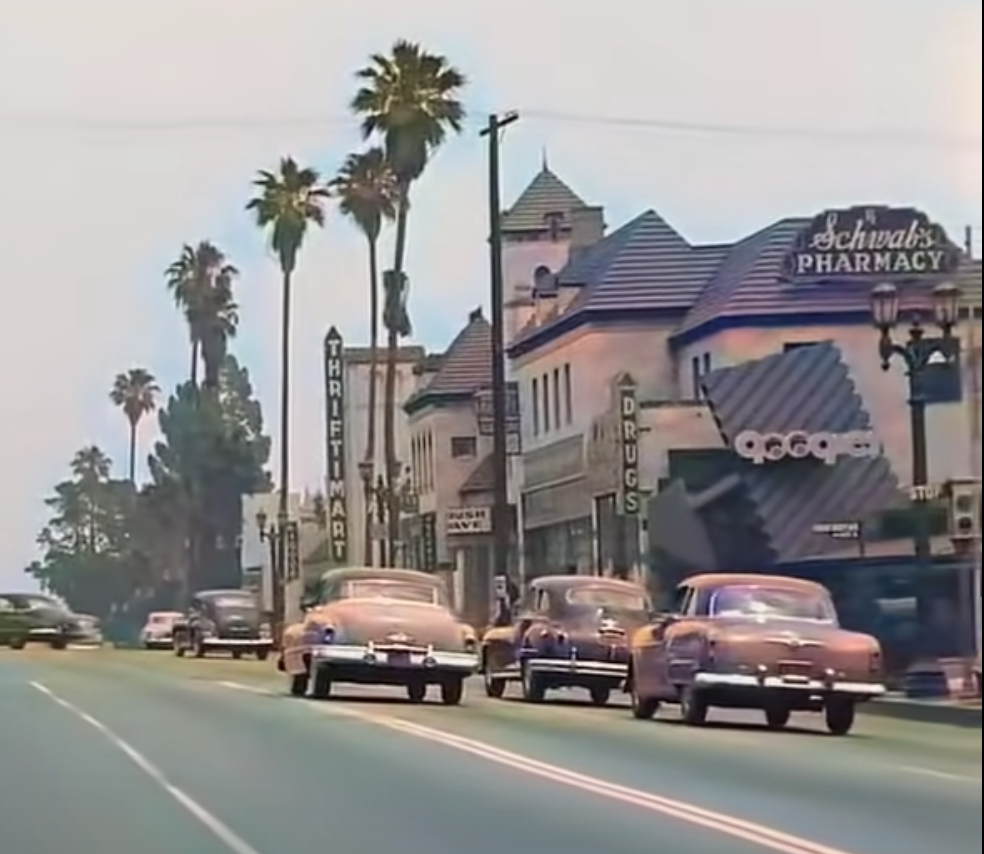
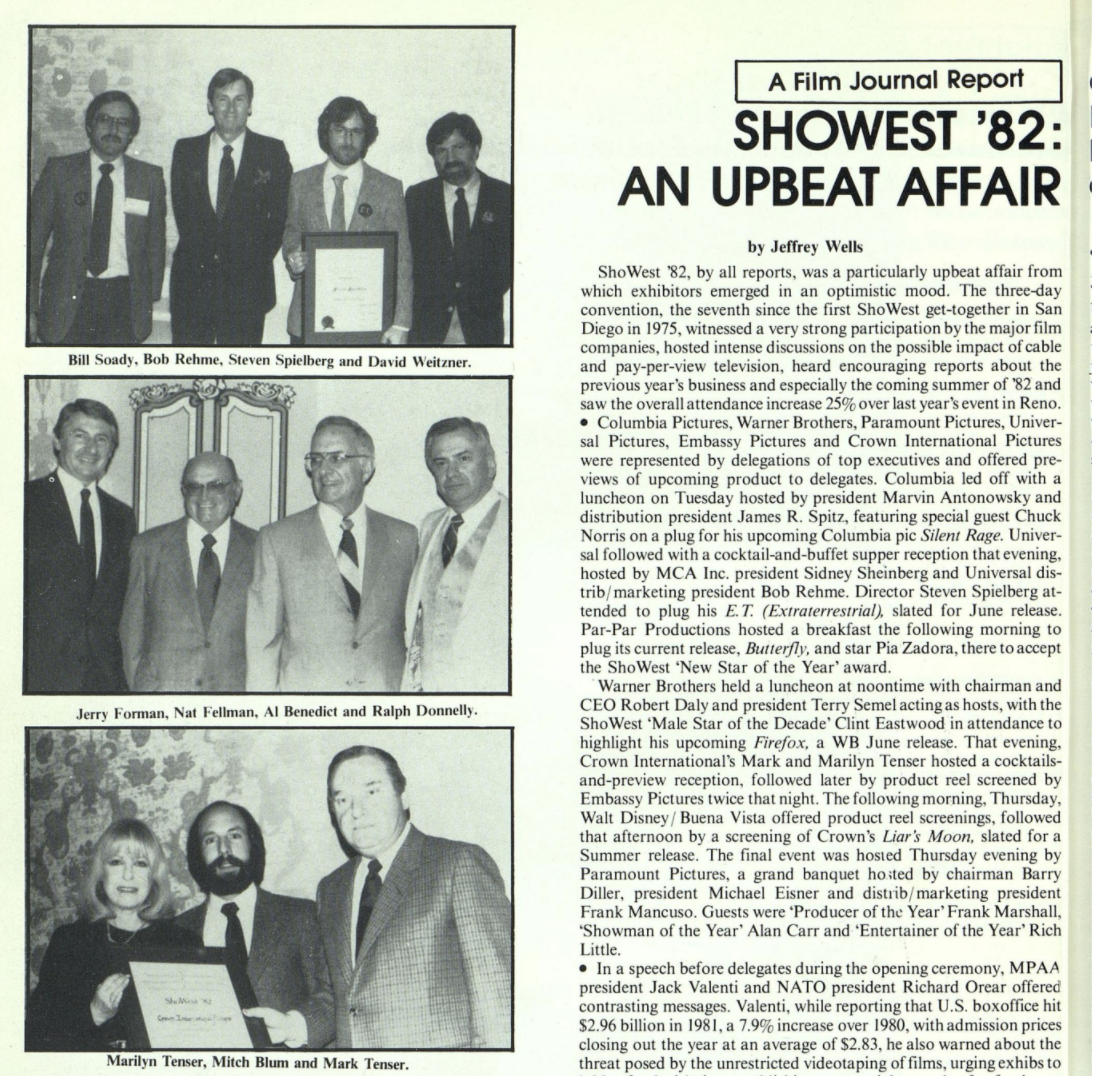


I’m not comfortable admitting that I have a weird soft spot for ruthlessly violent, rightwing Mel Gibson movies, as long as they’re efficiently made.





From P.J. O’Rourke‘s “How to Drive Fast on Drugs While Getting Your Wing-Wang Squeezed and Not Spill Your Drink“, written in the mid ’80s:
“When it comes to taking chances, some people like to play poker or shoot dice; other people prefer to parachute-jump, go rhino hunting, or climb ice floes, while still others engage in crime or marriage. But I like to get drunk and drive like a fool.
“Name me, if you can, a better feeling than the one you get when you’re half a bottle of Chivas in the bag with a gram of coke up your nose and a teenage lovely pulling off her tube top in the next seat over while you’re going a hundred miles an hour down a suburban side street. You’d have to watch the entire Mexican air force crash-land in a liquid petroleum gas storage facility to match this kind of thrill.
“If you ever have much more fun than that, you’ll die of pure sensory overload, I’m here to tell you.
“Is that any way to have fun? How would your mother feel if she knew you were doing this? She’d cry. She really would. And that’s how you know it’s fun. Anything that makes your mother cry is fun. Sigmund Freud wrote all about this. It’s a well-known fact.
“Of course, it’s a shame to waste young lives behaving this way – speeding around all tanked up with your feet hooked in the steering wheel while your date crawls around on the floor mats opening zippers with her teeth and pounding on the accelerator with an empty liquor bottle. But it wouldn’t be taking a chance if you weren’t risking something. And even if it is a shame to waste young lives behaving this way, it is definitely cooler than risking old lives behaving this way.
“I mean, so what if some fifty-eight-year-old butt-head gets a load on and starts playing Death Race 2000 in the rush-hour traffic jam? What kind of chance is he taking? He’s just waiting around to see what kind of cancer he gets anyway. But if young, talented you, with all of life’s possibilities at your fingertips, you and the future Cheryl Tiegs there, so fresh, so beautiful — if the two of you stake your handsome heads on a single roll of the dice in life’s game of stop-the-semi — now that’s taking chances! Which is why old people rarely risk their lives. It’s not because they’re chicken — they just have too much dignity to play for small stakes.
“It’s important to be drunk because being drunk keeps your body all loose, and that way, if you have an accident or anything, you’ll sort of roll with the punches and not get banged up so bad. For example, there was this guy I heard about who was really drunk and was driving through the Adirondacks. He got sideswiped by a bus and went head-on into another car, which knocked him off a bridge, and he plummeted 150 feet into a ravine. I mean, it killed him and everything, but if he hadn’t been so drunk and loose, his body probably would have been banged up a lot worse — and you can imagine how much more upset his wife would have been when she went down to the morgue to identify him.”
As we all know, Robert Zemeckis‘s Flight is about the disease of alcoholism. I responded well to this 11.2.12 release, in part, because I had become a sober person roughly nine months earlier — on 3.20.12. And yet the film contains a certain drunk-driving paradox. Because Denzel Washington‘s “Cpt. Whip Whitaker” saves his commercial plane from crashing by flying upside down. We’re led to understand that if Whip had been 100% sober he might not have rolled the plane over and saved the day.
But even if this isn’t what the film says, I’m thinking that this principle applies to some extent to car driving.
“A Wing and a Prayer,” posted on 9.23.12: If you’re driving your Lexus drunk your reaction time is slower than if you’re cold sober, and if you’re really stinko you’re definitely a menace to all humanity. But drunk or semi-drunk driving isn’t all bad, and sometimes it works. Or at least it did for me.
I know, I know — did I just say that? In today’s world DUI is a felony punishable by huge fines and jail time in some cases, and rightly so. But in the ’70s tens of thousands of people drove from place to place every night with a buzz-on and in some cases plain shitfaced, and some awful things resulted, I’m sure. But quite often, probably the vast majority of times, drunks just drove home and parked their cars and watched a little TV and went to sleep on the couch. And then woke up at 3 am, undressed and flopped in their bedroom.
May God forgive me but in my early drinking days when I lived in Wilton and Westport, Connecticut, I drove late at night with several beers and/or Jack Daniels on the rocks in my system, and I just cruised on through, and I mean weekend after weekend after weekend after weekend. No accidents, no fender benders, nothing. Others plowed their cars into ponds and trees and guard-rails, but not me.
There were times, in fact, when I drove down those winding country roads at high speeds and I would focus like a motherfucker, and I was convinced at times that I was driving like Paul Newman at Lime Rock.
I started to tell myself, in fact, that I drove better when half-bombed because I was less intimidated by the possibility of something going wrong. I drove without fear, without hesitation. I took those hairpin turns like a champ.
Present tense: In short, if you’re as good a driver as I was and you’re not flat-out wasted, driving with booze in your system isn’t such a bad thing. Or at least it doesn’t need to be. Would I drive drunk now? Of course not. I stopped drinking 8 and 2/3 years and I’m not an asshole. I’m just saying that I got away with it for years, and…well, I’ve said it.
It didn’t get the love it deserved, but John Lee Hancock‘s The Founder, which opened a little more than five years ago, is easily one of the most fascinating and easily re-watchable dramas of the 20teens — half character study and half hard-scrabble success story, and a film about a highly unusual protagonist — Michael Keaton‘s Ray Kroc — who straddles the line between admirable and not-so-admirable.
Most people don’t know what to do with a character like Kroc. Half-good and half-shifty characters are hard to relax with. It’s okay if a lead character is a bit of an ethical muddle, but audiences generally like their main protagonists to be more sympathetic than not.
Kroc and Scarlett O’Hara aside, what movie characters are the most memorable half-and-halfers? And don’t tell me that Charles Foster Kane belongs in this fraternity. Because he doesn’t.
The Founder is basically the story of how Kroc persuaded the earnest, slightly doltish, small-time-thinking McDonald brothers (Dick and Mick, respectively played by Nick Offerman and John Carroll Lynch) to let him franchise their small fast-food business and turn it into a super-sized empire.
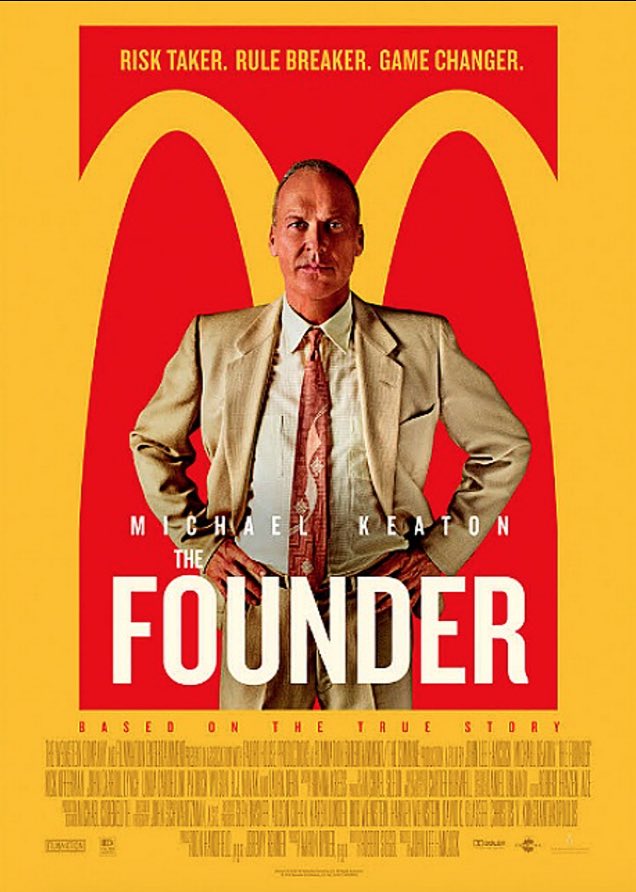
But more generally The Founder is a nuts-and-bolts story about what a scramble it is to grow a business and then stay afloat with all the serpents snapping at your heels.
Robert Siegel‘s script is a portrait of dog-eat-dog entrepenurial capitalism — a movie that basically says “sometimes it takes a pushy, manipulative shithead to orchestrate a big success.”
Except Keaton’s Kroc is not really a shithead. He’s just a hungry, wily go-getter who believes in the organizational basics that made McDonald’s a hit during its early California years (1948 to ’54) and who has the drive and the smarts to build it into a major money-maker. Your heart is basically with the guy, and I was surprised to feel this way after having nursed vaguely unpleasant thoughts about Kroc (scrappy Republican, Nixon and Reagan supporter) my entire life.
You know who is unlikable? Offerman’s Dick McDonald — a guy who’s always complaining, always frowning or bitching about something, always a stopper. The bottom line is that Dick doesn’t get it and neither does Mac, but Ray does. And to my great surprise I found myself taking Ray’s side and even chucking when he tells Dick to go fuck himself in Act Three. Ray is a bit of a prick but not a monster. And I understood where he was coming from. He’s a little shifty here and there, but I couldn’t condemn him all that strongly.
Keaton turns the key in just the right way. He doesn’t try to win you over but he doesn’t play Ray as a bad guy either — he plays it somewhere in between, and it’s that “in between” that makes The Founder feel quietly fascinating. It allows you to root for a not-so-nice-but-at-the-same-time-not-so-bad guy without feeling too conflicted.
And yet The Founder didn’t exactly burn up the box-office. It wound up grossing $12.8 million domestic and $24.1 million worldwide.
How do you whittle down the greatest-ever movie decade into a list of 15 films?
World of Reel‘s Jordan Ruimy is asking critics and other film neurotics to submit their lists of the 15 finest films of the ’70s, “ranked or unranked.” Fine, but with minor tweaks they’re all going to name the same films.
Let’s imagine for a second that the following are my top picks: (1) William Friedkin‘s The French Connection; (2) Peter Bogdanovich‘s The Last Picture Show; (3) Stanley Kubrick‘s A Clockwork Orange (4) Arthur Hiller and Paddy Chayefsky‘s The Hospital, (5) Robert Altman‘s McCabe & Mrs. Miller, (6) John Schlesinger’s Sunday Bloody Sunday, (7) Mike Hodges‘ Get Carter, (8) Sam Peckinpah‘s Straw Dogs, (9) Louis Malle‘s Murmur of the Heart, (10) Alan Pakula‘s Klute, (11) Luchino Visconti‘s Death in Venice, (12) Mike Nichols‘ Carnal Knowledge, (13) Hal Ashby‘s Harold and Maude, (14) Roman Polanski’s Macbeth and (15) Ken Russell‘s The Devils.
Well, guess what — they were all released in 1971! What about the other nine years?
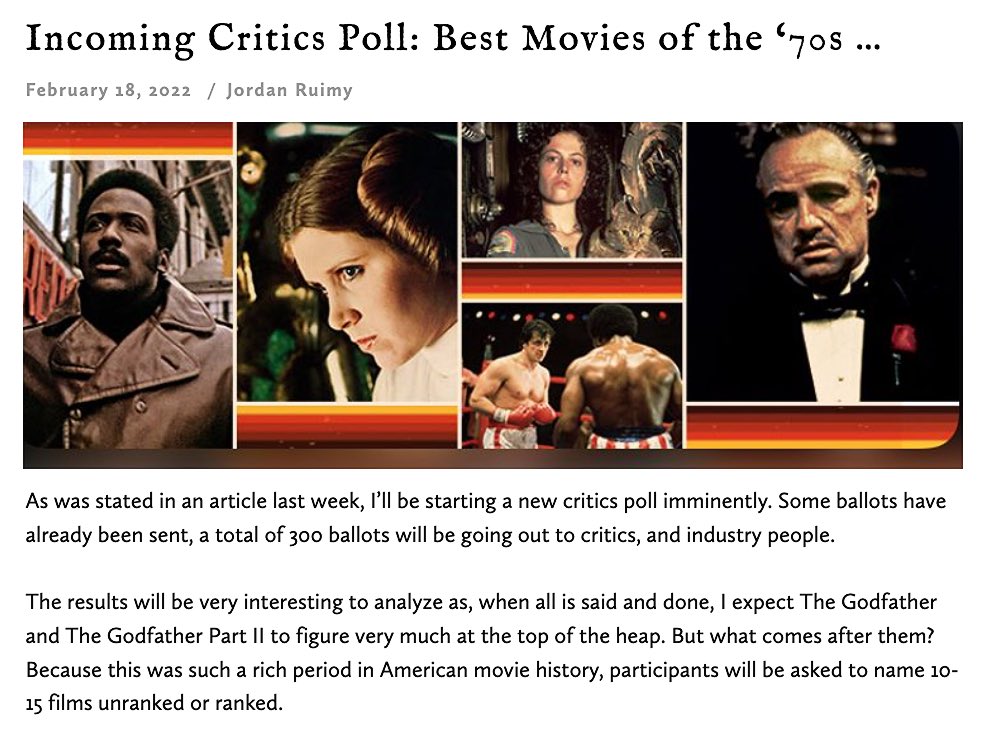
Here’s my actual 15 (ranked): 1. The Godfather (’72), 2. The Godfather, Part II (’74). 3. The French Connection (’71), 4. All The Presidents Men (’76), 5. Assault on Precinct 13 (’76), 6. Network (’76), 7. Serpico (’73), 8. The Last Detail (’73), 9. Chinatown (’74), 10. The Hospital (’71), 11. McCabe and Mrs. Miller (’71), 12. The Friends of Eddie Coyle (’73), 13. Mean Streets (’73), 14. Days of Heaven (’78), 15. Annie Hall (’77).
Just missed the mark…
16. A first-rate, handsomely produced war film driven entirely by character and fate, and with one of the greatest endings ever written (“All glory is fleeting”) — Patton (’70).
17. 75% of a great movie that’s mainly about itself (Coppola, grandiosity, Vittorio Storaro, tracking shots, cinematic opera, Wagner and Valkyries)…pretending to be a Vietnam War film — Apocalypse Now (’79).
18. Not a “great” film but a very good one that contains one of the greatest extended long-take, single-shot finales — The Passenger (’75).
19. A celebration of the rough and tumble that comes with blue-collar, Boston-area hockey + a dose of middle-aged what-the-hell — Slap Shot (’77).
20. Not a great film but a delicious, Damon Rynyon-esque crime fable that I’ve watched at least 10 or 12 times — The Sting (’73).
21. The greatest God’s Lonely Man movie ever made, Paul Schrader incarnate, etc. But the “dating Betsy” portion is ridiculous (Cybill Shepherd would go out with a psycho? He takes her to a 42nd Street porno film?) and the ending, which has always been quite clear to me, has confused too many for too long — Taxi Driver (’75).
22. Arguably the greatest Parisian mood flick ever, containing the most nakedly vulnerable Marlon Brando performance ever, and certainly the strangest, kinkiest and most compelling sexually-driven film-for-the-swells ever made — Last Tango in Paris (’72).
Top-Tier ’70s Films With Nagging Problems: 1. Barry Lyndon (dead-zone third act), 2. A Clockwork Orange (repetitive, overly coincidental plot turns, Alex is going to croon “Singing In The Rain” a second time in the victim’s bathroom?), 3. Halloween (best of the slashers, but a fairly ridiculous conceit), 4. Close Encounters of the Third Kind (dozens of bothersome elements), 5. The Deer Hunter (tedious, overlong opening concerning a Pennsylvania blue-collar wedding, ridiculous Russian roulette playing in Vietnam), 6. Frenzy (lacks tension, believability in some sections), 7. One Flew Over The Cuckoo’s Nest (decent social parable but way over-praised, McMurphy could have left at any time but he stuck around for a lobotomy?), 8. Nashville (snide attitude towards country-music yahoos), 9. Jaws (crafty popcorn excitement but don’t call it a great film), 10. Dirty Harry (smug, unbelievable in some respects), 11. Star Wars (huge hit, iconic franchise launch, nowhere near as good as The Empire Strikes Back), 12. Harold and Maude (too precious); 13. Dog Day Afternoon (absorbing heist dramedy with fascinating lead chgracter, but I didn’t believe Al Pacino‘s bank robber was gay…he didn’t quite convince me).
We all know what “learn” means in this context. Bryan Cranston seems to be more or less saying “forgive my privileged white guy sins, which we all know are considerable. Should I list them alphabetically? My shame is absolute.”

Decades ago I read a Charles Bukowski recollection about the glorious results of a long, deep sleep. The author-poet had slept for two days straight, and when he finally awoke he felt wonderful. Bukowski’s body felt like $10 million bucks, etc. So I decided to follow suit. Lights out at 9 pm, a good 10 or 11 hours.
I woke up at 1:30 am and couldn’t get back to sleep. I studied my Twitter feed for an hour or so, and then decided to re-watch Steven Spielberg‘s The Post (’17) on the phone. My reaction was roughly the same as it was four years ago — respected the effort, loved the performances, admired Liz Hannah and Josh Singer‘s well-honed script, felt a certain emotional poignancy toward the end.
The Post was nominated for Best Picture and Best Actress (Streep) at the 90th Academy Awards, but Academy members mostly ignored it — identity politics and representation of historically devalued groups were the big concerns. If you ask me The Post didn’t deserve to be dismissed as a self-congratulating, middle-class, big-studio film about journalistic integrity, made by and for well-off, well-educated whiteys. But that’s how a certain percentage of the Academy saw it.
The Post isn’t a journalistic procedural as much as a feminist parable — a story about how Washington Post publisher Katherine Graham (Meryl Streep), who initially saw herself as less than ideally suited to the task and little more than a blandly embedded figure in Washington social circles, gradually grew some courage and a sense of journalistic purpose during the Pentagon Papers episode, which transpired over a 17-day period in June 1971.
In this light, the key scene — Spielberg’s signature moment — comes when Streep emerges from a historic Supreme Court session about the legality of publishing the Pentagon Papers, and several women on the steps gaze with admiration as she passes by.
On the other hand I found myself distracted by those klutzy moments that Spielberg always puts into his films — little errors of judgments that normalize characters by making them seem vulnerable. Graham waking up in her bedroom with several books and files on her bed, and of course they all fall from the bed and onto the floor, loudly. Graham meeting Ben Bradlee (Tom Hanks) inside a posh Washington restaurant, and of course she stumbles and accidentally knocks over a chair. An open-mouthed Washington Post intern visits the N.Y. Times building on West 43rd street, and as he starts to cross the street you just know he’ll almost get hit by a taxi…sure enough, that happens. (I’m fairly sure that another cab screeches to a stop later on.)
I finally got back to sleep at 5:30 am. The Bukowski sleep-in thing will have to wait.
Hollywood Elsewhere suspects that classic-film distributor and alleged rights-squatter Wade Williams, the apparent owner of distribution rights to William Cameron Menzies‘ Invaders From Mars (’53) since the mid ’70s, has a top-secret plan for creating and then distributing a restored 4K Bluray of this legendary impressionist classic.
It was just over five years ago when Williams projected, in a letter to director Joe Dante, that a high-grade restoration of Invaders elements was probably just around the corner and that a reputable distributor of this restored film would soon emerge.
But of course, Williams being Williams, nothing ever happened.
HE can now officially share the above-referenced, fully considered suspicion. Wade’s plan may involve waiting for the inevitable deaths of hundreds of thousands of the film’s boomer-aged fans — movie fanatics who were deeply impressed by Invaders‘ spooky vibe and penetrtating, dream-like hallucinatory impressions during their soft-clay years.
It is entirely reasonable to suspect that Wade’s plan may be to wait for these film buffs (particularly boomers who experienced said reactions to Menzies’ film in their adolescent years)…it’s quite possible that the plan is to wait until all the boomer-aged fans of this film are dead and gone. Once departed and their remains scattered to the winds, Williams will finally assist with a restoration effort and then release and approve a 4K scan of the best extant materials.
Then again a respected inside-track guy who knows all the players has confided the following: “From my knowledge, Wade Williams doesn’t hold controlling rights to Invaders From Mars, nor does he control the original camera negative, so any activity that may occur need not have his approval.”
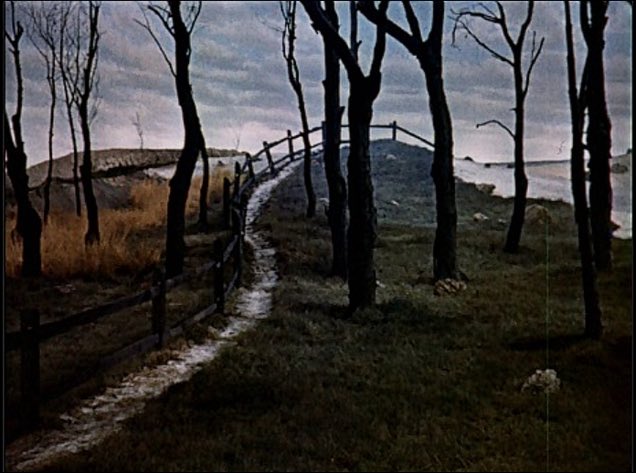
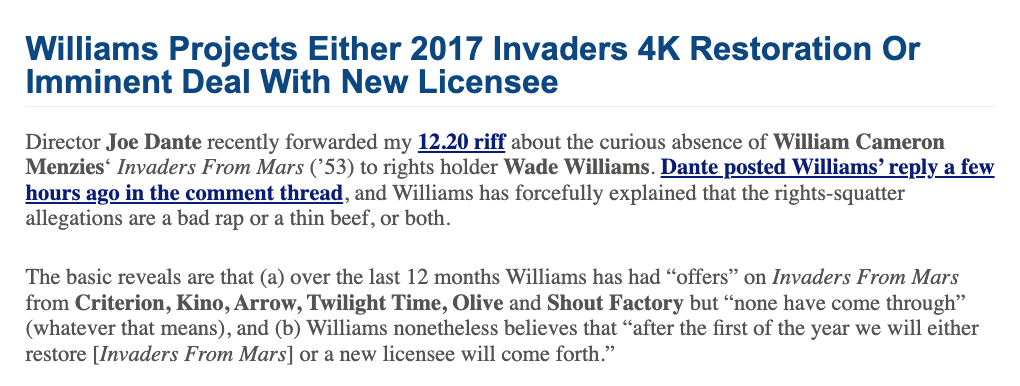
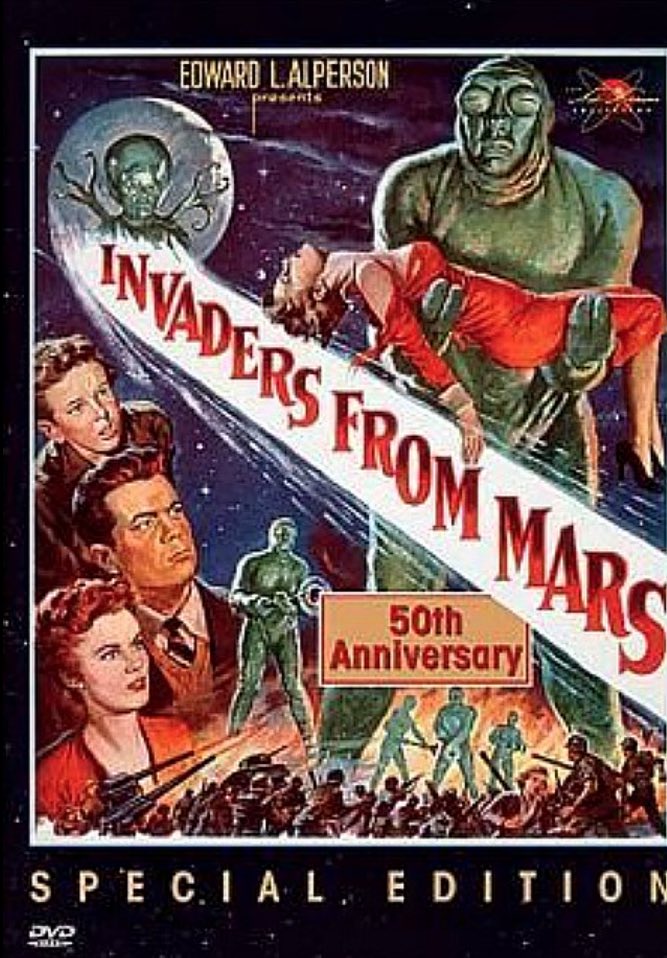
As I mentioned last week I’m in the midst of selling the rumblehog and trying to buy a nice little tool-around car — $4K or less. No daily commuting, no long trips, steady as she goes. I’ve looked at several modest vehicles that seemed promising, but which were quickly sold before I had a chance to clear my throat and make a move.
The basic rule is “take a test drive, look the seller in the eye, and then buy with your gut.” That’s because sellers are always evasive when I ask for the VIN# (basic history search), which of course makes me suspicious. And with most of the sellers living in outlying burghs like Compton, Bell Gardens, Long Beach, Santa Ana or Camarillo, arranging to show the vehicle to my West Hollywood mechanic (standard procedure for any sensible person) is damn near impossible.
I’ve been seriously focused on six or seven cars over the last ten days and they were all sold before I had a chance to talk turkey. So if I’m willing to buy a car without having time to search the VIN# (buyers have been resisting this request during initial texting) and I’m willing to buy it without my trustworthy local mechanic (Carlos at the corner of Fairfax and Melrose) having a looksee, I might be able to make the deal.
But if I think cautiously or methodically and meticulously — any stalling or any kind of step-by-step inquiry, or even trying to arrange for a mere verbal conversation — if I do or say anything other than “Yes, I’ll be right over with the money!” — somebody else will swoop in and buy it within a day, and sometimes within hours.
Compton seller last week: “Everyone knows that if you buy a ten-year-old car, you’re buying a car that will experience a few problems. There are no whistle-clean deals…no blemish-free, pure-as-the-driven-show used cars. You just have accept that and go with your gut…”
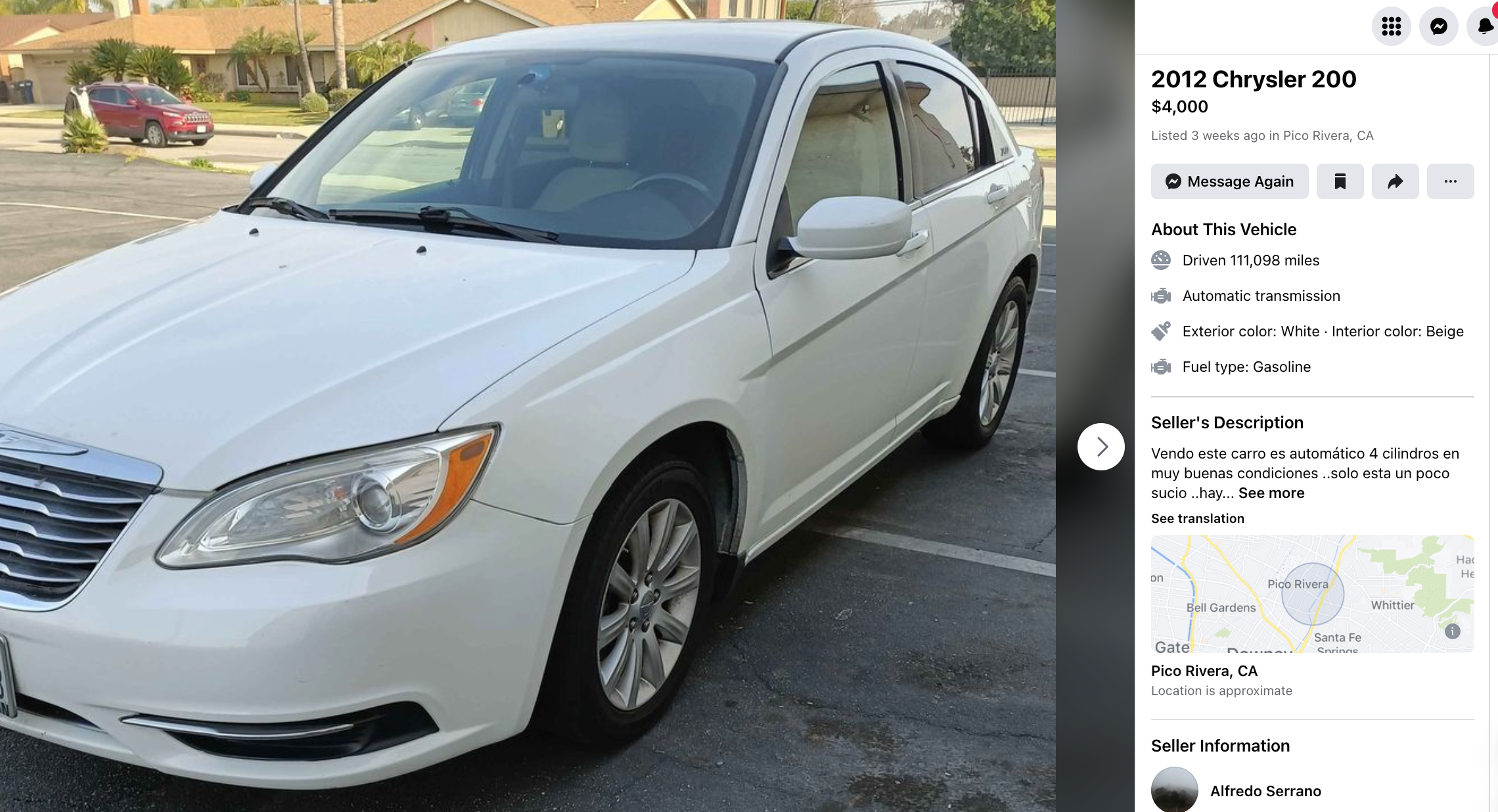
Exactly three years ago I slipped on some ice in the Sierra foothills, just south of Mt. Whitney. It was totally my fault for having worn my brown suede Bruno Magli lace-ups in a sloping area that was experiencing an icy snowfall at the moment.
Nothing was broken but over the following three or four weeks I was agony. Sleeping was quite difficult; so was breathing at times. A cane was my constant companion. From the instant I fell I was the antithesis of Lee Marvin toughness. I even wept a couple of times.

Posted on 2.17.19: It was chilly and gently snowing as Tatyana and I trudged around a snow-packed area near a blocked-off road in the Sierras, south of Mt. Whitney. Took some nice shots, a good slow-pan video, satisfaction.
On the way back to the car I stepped on a harmless-looking patch of snow which had suddenly become icy. Total slip-out, feet in the air and a terrible crashing collision.
I literally heard a slight snapping or cracking sound as I hit the ground. I half-landed on my right arm and half on my right rib area. It hurt like a bastard plus my wind was knocked out. For five or ten seconds I whined and moaned like a candy-ass. If Lee Marvin had been there he would’ve been ashamed of me. Or for me.
I eventually got up and managed a brusque “I’m okay.” 100 feet later I fell again. Fucking 25 degree downward angle plus that icy snowfall. Then we couldn’t get the car out of the parking lot due to the same slick ice. After some struggling we figured it out. Jesus.
No broken wrist or broken arm, no leg bruise, 100% arm, hand, leg and neck mobility, no lung damage and just a couple of small cuts on my right hand. But my right rib cage aches like a sonuvabitch.
As we speak Tatyana is driving me to a Cedars Sinai Urgent Care clinic on Wilshire near La Cienega. What are they gonna do if I have a cracked rib? Wrap my mid-section in one of those high-tension bandages? Prescribe some pain pills?
X–Ray Result: No cracked ribs. But at the risk of sounding repetitive, it fucking hurts.
Erik Anderson‘s kneejerk, groaningly familiar view of Elvis Presley and, by current extension, Baz Luhrmann‘s Elvis is going to be with us for several months to come.
Racism is obviously alive and well in many pockets of the country today, but the kind of racism that penetrated most of the USA in the early to mid ’50s was more virulent and less modified. People of color were saddled with all sorts of unpleasant associations, and one of the offshoots was that rhythm and bluesy versions of “race music”, or what came to be known in the ’50s as rock ‘n roll, were regarded askance, particularly by the parents of baby boomers.
Teenage kids of the James Dean generation loved Chuck Berry, Little Richard and Fats Domino (ditto the younger boomers who were tweeners at the time), but their parents were appalled and many radio stations were concerned by the implications of raw, lewd sexuality that black music seemed to contain.
Hence the famous Sam Phillips quote: “I always said that if I could find a white boy who could sing like a black man I’d make a million dollars.”

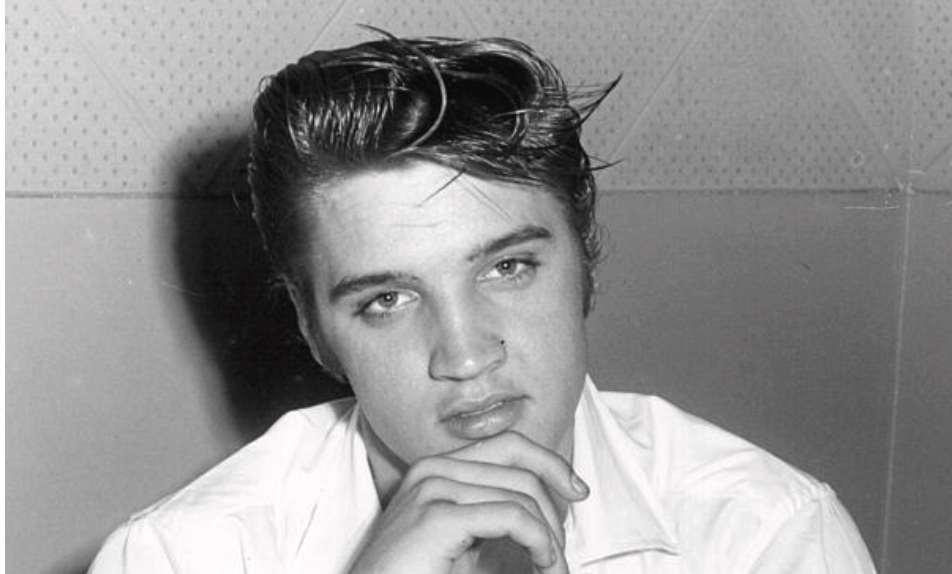
Presley may have grown into a drug-dependent asshole when he get older and perhaps less and less respectful of his roots, but by all accounts he genuinely loved “negro” spiritual music as a young kid.
“A lot of people in retrospect attack Elvis for stealin` the black music and making it white. I say Elvis Presley had a black soul with a white face” — Michael Ochs.
“I don’t think he [Elvis] ripped ’em off,” B.B. King said. “I think once something has been exposed, anyone can add or take from it if they like. He was just so great, so popular, and so hot — and so anything that he played became a hit. To me, they didn’t make a mistake when they called him The King.”
In the ’50s Presley’s music was popular in the black community. As noted by Michael Bertrand, author of “Race, Rock and Elvis”, between April 1956 and September 1958, Presley had 22 songs among the Top 15 on Billboard’s rhythm and blues charts — charts that were “meant to capture the tastes of black listeners and buyers.”
“A lot of people have accused Elvis of stealing the black man’s music,” said soul singer Jackie Wilson, “when in fact, almost every black solo entertainer copied his stage mannerisms from Elvis.”
Presley to Jet‘s Louie Robinson: “A lot of people seem to think I started this business, but rock ‘n’ roll was here a long time before I came along. Nobody can sing that kind of music like colored people. Let’s face it –I can’t sing it like Fats Domino can. I know that. But I always liked that kind of music. I used to go to the colored churches when I was a kid — like Rev. Brewster’s church [in Memphis].”
Quote: “Presley’s genius was his ability to mix multiple styles of music from the white and black cultures. Early in his career, a Memphis columnist summarized Presley’s singing style: “He has a white voice [and] sings with a negro rhythm which borrows in mood and emphasis from country style.”
Two days ago I wrote that Austin Butler doesn’t look enough like Elvis — at best he’s a young John Travolta. The new trailer suggests that Butler doesn’t have the surly Elvis drawl either. (Kurt Russell‘s Elvis voice was ten times better.) It’s one thing to not resemble Elvis but to sound like him, and another thing to not have the voice but to own a serious look-alike thing, but to come up short on both counts is a huge problem — it really is.
Forget reanimating the actual long-gone Elvis of yore — Butler doesn’t even seem like a good Elvis imitator. He just doesn’t have it.
And yet Baz Luhrman‘s Elvis trailer gets one thing absolutely right — it conveys the effect of Presley’s explosive sexual current and how the wiggles and pelvic thrusts made young girls pant, or at the very least pause.
All this time I’ve been wondering if the Elvis guys (director-writer Luhrman, screenwriters Sam Bromell, Craig Pearce and Jeremy Doner) would be including the “fat Elvis” chapter, or roughly the last three years of his life. Unless the trailer is lying by omission, the apparent answer is “no.”
There is, however, a seriously fat Tom Hanks as Colonel Tom Parker, and he’s wearing one of the best fat suits I’ve ever seen in a film…seriously, hats off. Or do I mean “fats off”?
I can’t seem to identify the fair-haired kid who plays 11 year-old Elvis in Tupelo, but this is almost exactly what Elvis looked like as a tweener. Odd that Luhrmann chose correctly in this realm, and yet totally dropped the ball with the adult-sized version.